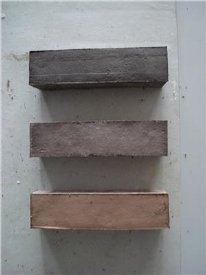Oct 5 2010
Spanish and Scottish researchers have added wool fibres to the clay material used to make bricks and combined these with an alginate, a natural polymer extracted from seaweed. The result is bricks that are stronger and more environmentally-friendly, according to the study published recently in the journal Construction and Building Materials.
"The objective was to produce bricks reinforced with wool and to obtain a composite that was more sustainable, non-toxic, using abundant local materials, and that would mechanically improve the bricks' strength", Carmen Galán and Carlos Rivera, authors of the study and researchers at the Schools of Architecture in the Universities of Seville (Spain) and Strathclyde (Glasgow, United Kingdom), tell SINC.
 Bricks made with wool. Image: Galán-Marín et al.
Bricks made with wool. Image: Galán-Marín et al.
The wool fibres were added to the clay material used in the bricks, using alginate conglomerate, a natural polymer found in the cell walls of seaweed. The mechanical tests carried out showed the compound to be 37% stronger than other bricks made using unfired stabilised earth.
The study, which has been recently published in the Journal Construction and Building Materials, was the result of close collaboration between the British and Spanish universities. The clay-based soils were provided by brick manufacturers in Scotland, which was also the source of the wool, since the local textile industry cannot use everything it produces. "The aim was to produce a material suitable for adverse climatic conditions, such as the specific ones in the United Kingdom", the authors explain.
Advantages of environmentally-friendly bricks
The researchers studied the effect of reinforcing various soil types with sheep's wool, and arrived at various conclusions. "These fibres improve the strength of compressed bricks, reduce the formation of fissures and deformities as a result of contraction, reduce drying time and increase the bricks' resistance to flexion".
This piece of research is one of the initiatives involved in efforts to promote the development of increasingly sustainable construction materials. These kinds of bricks can be manufactured without firing, which contributes to energy savings. According to the authors: "This is a more sustainable and healthy alternative to conventional building materials such as baked earth bricks and concrete blocks".
Untreated clay was one of the earliest building materials to be used by humankind. The oldest examples of this can be found in houses in the Near East dating from between 11,000 and 12,000 years ago. Earthy material mixed with plants and pebbles to make them stronger has also been found in certain archaeological deposits from 1400BCE in Sardinia (Italy).